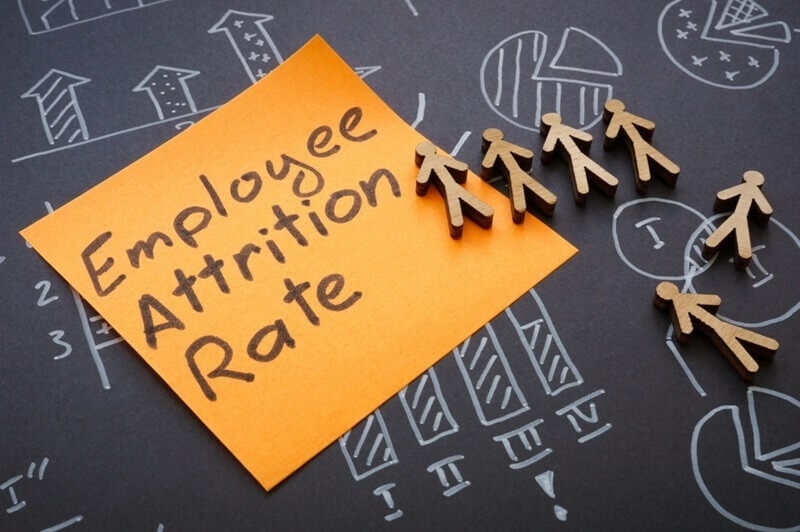
Every workplace goes through some changes when employees leave and some roles disappear. These things slowly and steady reshapes of the complete business. This process of change is known as employee attrition. It is not just about exits, but also about the decision not to refill those roles. Knowing what is employee attrition, how it differs from turnover, and what the employee attrition rate means helps organizations understand the story behind these changes.
Employee attrition happens when employees leave and their positions remain vacant. The company does not hire someone else for the role, either for a long time or permanently. Over time, this reduces the workforce. It might occur across the company or within a single team.
Sometimes attrition happens because a role is no longer needed. Maybe technology has taken over that function, or the company has shifted focus. Other times, it is a natural part of people moving on in life. The key point is that attrition reduces headcount gradually, not suddenly.
Attrition can seem negative, but it does not always mean something is wrong. Sometimes it is simply the natural way organizations evolve.
Must Read: Top 10 Employee Engaging Activities for Workplace Happiness
Employee turnover and attrition are often mixed up. The two words sound similar but mean very different things.
Turnover means employees leave, but the company replaces them. If a person resigns and the role is filled within weeks, that is turnover. Attrition, on the other hand, means employees leave and the role is not filled again. It remains vacant or is removed.
Think of turnover as a revolving door where people leave but others enter to replace them. Attrition is more like a door closing behind someone with no one else walking in. This difference between employee turnover vs attrition is important because it changes how a company measures workforce stability.

There are many causes of employee attrition. Some are voluntary, while others are driven by organisational decisions.
Employees resign for personal reasons such as career growth, lifestyle change, or family priorities.
Sometimes the company removes roles during restructuring, mergers, or policy changes.
As automation grows, certain roles naturally disappear because machines or systems handle them.
Instead of rehiring for a role, a company may spread the tasks across existing employees.
Work may move to external partners, leaving internal roles unfilled.
Each cause shapes attrition differently. Some reasons are part of natural business progress, while others signal deeper shifts.
Looking closer, the reasons for employee attrition fall into a few simple groups.
Employees may leave if leadership is weak, recognition is low, or growth opportunities are missing.
Companies sometimes reduce focus on certain areas and choose not to refill those positions.
Personal factors like health, retirement, or relocation naturally leads to attrition.
These reasons remind us that attrition cannot always be stopped. Sometimes it reflects employee needs, and sometimes it reflects business choices.
Attrition is not just one thing. It comes in different forms that help explain why positions go unfilled.
Employees resign by choice, and the company decides not to replace them.
The company removes a role altogether, leaving it vacant.
Low performers exit, and the company does not fill their roles again.
Certain groups, like those retiring, gradually reduce the workforce size.
Looking at these types gives leaders a better sense of whether attrition is natural, performance-driven, or structural.
The employee attrition rate measures how many employees leave without being replaced. It is calculated by dividing the number of exits without replacement by the average headcount, then multiplying by 100.
For example, if 35 people leave out of 1500, and none of those roles are filled, the attrition rate is about 2.3%. This number tells how much the team has shrunk over time.
A small rate may be acceptable, but a high one may signal deeper issues. Tracking the employee attrition rate regularly helps organizations keep an eye on their workforce health.
Numbers alone do not explain attrition fully. Companies must analyze patterns to see what is really happening.
By analyzing attrition in detail, organizations can understand the real reasons behind workforce changes and prepare better strategies.
Attrition does not always harm the workplace. In some cases, it can actually be helpful.
If a role is no longer needed, attrition naturally reduces it without layoffs.
Employees can take on new duties, which helps them grow professionally.
As business strategies or technology change, attrition allows smooth adjustments.
Seen this way, attrition is sometimes just part of natural organizational progress.
Even though attrition cannot be stopped fully, it can be managed well with thoughtful practices.
Since poor management is a top reason for exits, building strong leaders helps reduce attrition.
Career development and training provide a better employee experience which gives them a reason to plan their future with the company.
Feedback sessions and stay interviews help address problems before people leave.
Remote work or flexible schedules make it easier for employees to balance life.
Bringing in people who fit the role and culture reduces future attrition.
Managing attrition is about keeping employees engaged while also adjusting naturally to the company’s needs.
Employee attrition shows how teams change when roles remain unfilled after employees leave. By looking at employee turnover vs attrition, the causes of employee attrition, and the employee attrition rate, organizations understand workforce shifts more clearly. With careful management, attrition can be handled in a way that keeps the workplace stable and ready for change.
This content was created by AI